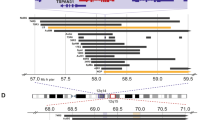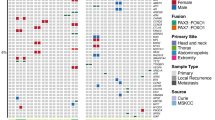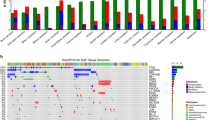Abstract
Purpose
SMARCB1/INI1, which negatively regulates cell cycle progression from G0/G1 into the S-phase via the p16INK4a-RB-E2F pathway, has been reported to be inactivated homozygously by deletion and/or mutations in malignant rhabdoid tumor (MRT). In the current study, we investigated the alteration of the SMARCB1/INI1 gene using simple methods, and its gene product at the protein level. Moreover, we investigated the status of hyperphosphorylation in RB protein, known as a key cell cycle molecule.
Methods
Three cell lines and 11 formalin-fixed, paraffin-embedded specimens of MRT were investigated. SMARCB1/INI1 gene alteration was analyzed with simple methods as a quantitative real-time PCR and direct sequencing method. Furthermore, SMARCB1/INI1 and RB protein were immunohistochemically evaluated.
Results
In 12 of 14 cases, we detected genetic alterations comprised of nine (including three cell lines) homozygous deletions and three mutations, which can induce abnormal expression of gene products. At the protein level, SMARCB1/INI1 immunohistochemical expressions were not detected in any cases. Twelve out of 14 cases showed high-level (+5) expression of tRB (both hyperphosphorylated and underphosphorylated RB), combined with low-level (+1) expression of uRB (underphosphorylated RB), indicating a high rate of hyperphosphorylation.
Conclusions
We could analyze the SMARCB1/INI1 gene alteration with simple methods, and SMARCB1/INI1 gene alteration was found in 12 of 14 cases. Especially, quantitative real-time PCR was a convenient and accurate method. In addition, a high rate of hyperphosphorylation of RB gene was recognized. These results suggest that the clinically aggressive character of MRT is caused by the inactivation of the SMARCB1/INI1 gene.




Similar content being viewed by others
Abbreviations
- MRT:
-
Malignant rhabdoid tumor
- EMRT:
-
Extrarenal malignant rhabdoid tumor
- MRTK:
-
Malignant rhabdoid tumor of the kidney
- tRB:
-
Both hyperphosphorylated and underphosphorylated RB
- uRB:
-
Underphosphorylated RB
- Ct:
-
Threshold cycle numbers
- GDR:
-
Gene dosage ratio
References
Aveyard JS, Knowles MA (2004) Measurement of relative copy number of CDKN2A/ARF and CDKN2B in bladder cancer by real-time quantitative PCR and multiplex ligation-dependent probe amplification. J Mol Diagn 6:356–365
Beckwith JB, Palmer NF (1978) Histopathology and prognosis of Wilms tumors: results from the first national Wilms’ tumor study. Cancer 41:1937–1948
Berggren P, Kumar R, Sakano S, Hemminki L, Wada T, Steineck G, Adolfsson J, Larsson P, Norming U, Wijkstrom H, Hemminki K (2003) Detecting homozygous deletions in the CDKN2A(p16(INK4a))/ARF(p14(ARF)) gene in urinary bladder cancer using real-time quantitative PCR. Clin Cancer Res 9:235–242
Biegel JA, Rorke LB, Packer RJ, Emanuel BS (1990) Monosomy 22 in rhabdoid or atypical tumors of the brain. J Neurosurg 73:710–714
Biegel JA, Zhou JY, Rorke LB, Stenstrom C, Wainwright LM, Fogelgren B (1999) Germ-line and acquired mutations of INI1 in atypical teratoid and rhabdoid tumors. Cancer Res 59:74–79
Biegel JA, Kalpana G, Knudsen ES, Packer RJ, Roberts CW, Thiele CJ, Weissman B, Smith M (2002a) The role of INI1 and the SWI/SNF complex in the development of rhabdoid tumors: meeting summary from the workshop on childhood atypical teratoid/rhabdoid tumors. Cancer Res 62:323–328
Biegel JA, Tan L, Zhang F, Wainwright L, Russo P, Rorke LB (2002b) Alterations of the hSNF5/INI1 gene in central nervous system atypical teratoid/rhabdoid tumors and renal and extrarenal rhabdoid tumors. Clin Cancer Res 8:3461–3467
Bonnin JM, Rubinstein LJ, Palmer NF, Beckwith JB (1984) The association of embryonal tumors originating in the kidney and in the brain. A report of seven cases. Cancer 54:2137–2146
Hoot AC, Russo P, Judkins AR, Perlman EJ, Biegel JA (2004) Immunohistochemical analysis of hSNF5/INI1 distinguishes renal and extra-renal malignant rhabdoid tumors from other pediatric soft tissue tumors. Am J Surg Pathol 28:1485–1491
Imbalzano AN, Jones SN (2005) Snf5 tumor suppressor couples chromatin remodeling, checkpoint control, and chromosomal stability. Cancer Cell 7:294–295
Izumi T, Oda Y, Hasegawa T, Nakanishi Y, Iwasaki H, Sonobe H, Goto H, Kusakabe H, Takahira T, Kobayashi C, Kawaguchi KI, Saito T, Yamamoto H, Tamiya S, Iwamoto Y, Tsuneyoshi M (2006) Prognostic significance of dysadherin expression in epithelioid sarcoma and its diagnostic utility in distinguishing epithelioid sarcoma from malignant rhabdoid tumor. Mod Pathol 19:820–831
Judkins AR, Mauger J, Ht A, Rorke LB, Biegel JA (2004) Immunohistochemical analysis of hSNF5/INI1 in pediatric CNS neoplasms. Am J Surg Pathol 28:644–650
Kingston RE, Bunker CA, Imbalzano AN (1996) Repression and activation by multiprotein complexes that alter chromatin structure. Genes Dev 10:905–920
Kinoshita Y, Shiratsuchi H, Tamiya S, Oshiro Y, Hachitanda Y, Oda Y, Suita S, Tsuneyoshi M (2001a) Mutations of the p53 gene in malignant rhabdoid tumors of soft tissue and the kidney: immunohistochemical and DNA direct sequencing analysis. J Cancer Res Clin Oncol 127:351–358
Kinoshita Y, Tamiya S, Oda Y, Mimori K, Inoue H, Ohta S, Tajiri T, Suita S, Tsuneyoshi M (2001b) Establishment and characterization of malignant rhabdoid tumor of the kidney. Oncol Rep 8:43–48
Labuhn M, Jones G, Speel EJ, Maier D, Zweifel C, Gratzl O, Van Meir EG, Hegi ME, Merlo A (2001) Quantitative real-time PCR does not show selective targeting of p14(ARF) but concomitant inactivation of both p16(INK4A) and p14(ARF) in 105 human primary gliomas. Oncogene 20:1103–1109
Modena P, Lualdi E, Facchinetti F, Galli L, Teixeira MR, Pilotti S, Sozzi G (2005) SMARCB1/INI1 tumor suppressor gene is frequently inactivated in epithelioid sarcomas. Cancer Res 65:4012–4019
Oda Y, Tsuneyoshi M (2006) Extrarenal rhabdoid tumors of soft tissue: clinicopathological and molecular genetic review and distinction from other sort-tissue sarcomas with rhabdoid features. Pathol Int 56:287–295
Orjuela M, Castaneda VP, Ridaura C, Lecona E, Leal C, Abramson DH, Orlow I, Gerald W, Cordon-Cardo C (2000) Presence of human papilloma virus in tumor tissue from children with retinoblastoma: an alternative mechanism for tumor development. Clin Cancer Res 6:4010–4016
Polsky D, Mastorides S, Kim D, Dudas M, Leon L, Leung D, Woodruff JM, Brennan MF, Osman I, Cordon-Cardo C (2006) Altered patterns of RB expression define groups of soft tissue sarcoma patients with distinct biological and clinical behavior. Histol Histopathol 7:743–752
Rassidakis GZ, Lai R, Herling M, Cromwell C, Schmitt-Graeff A, Medeiros LJ (2004) Retinoblastoma protein is frequently absent or phosphorylated in anaplastic large-cell lymphoma. Am J Pathol 164:2259–2267
Roberts CW, Orkin SH (2004) The SWI/SNF complex–chromatin and cancer. Nat Rev Cancer 4:133–142
Schofield D (2002) Extrarenal rhabdoid tumour. In: Fletcher CDM, Unni KK, Mertens F (eds) WHO classification of tumours, pathology and genetics of tumours of soft tissue and bone. IARG Press, Lyon, France, pp 219–220
Sevenet N, Lellouch-Tubiana A, Schofield D, Hoang-Xuan K, Gessler M, Birnbaum D, Jeanpierre C, Jouvet A, Delattre O (1999) Spectrum of hSNF5/INI1 somatic mutations in human cancer and genotype-phenotype correlations. Hum Mol Genet 8:2359–2368
Shiratsuchi H, Saito T, Sakamoto A, Itakura E, Tamiya S, Oshiro Y, Oda Y, Toh S, Komiyama S, Tsuneyoshi M (2002) Mutation analysis of human cytokeratin 8 gene in malignant rhabdoid tumor: a possible association with intracytoplasmic inclusion body formation. Mod Pathol 15:146–153
Sigauke E, Rakheja D, Maddox DL, Hladik CL, White CL, Timmons CF, Raisanen J (2006) Absence of expression of SMARCB1/INI1 in malignant rhabdoid tumors of the central nervous system, kidneys and soft tissue: an immunohistochemical study with implications for diagnosis. Mod Pathol 19:717–725
Tsuneyoshi M, Daimaru Y, Hashimoto H, Enjoji M (1985) Malignant soft tissue neoplasms with the histologic features of renal rhabdoid tumors: an ultrastructural and immunohistochemical study. Hum Pathol 16:1235–1242
Versteege I, Sevenet N, Lange J, Rousseau-Merck MF, Ambros P, Handgretinger R, Aurias A, Delattre O (1998) Truncating mutations of hSNF5/INI1 in aggressive paediatric cancer. Nature 394:203–206
Vries RG, Bezrookove V, Zuijderduijn LM, Kia SK, Houweling A, Oruetxebarria I, Raap AK, Verrijzer CP (2005) Cancer-associated mutations in chromatin remodeler hSNF5 promote chromosomal instability by compromising the mitotic checkpoint. Genes Dev 19:665–670
Xu XC, Clifford JL, Hong WK, Lotan R (1994) Detection of nuclear retinoic acid receptor mRNA in histological tissue sections using non-radioactive in situ hybridization histochemistry. Diagn Mol Pathol 3:122–131
Acknowledgments
This study was supported by a Grant-in-Aid for Scientific Research (C) (no. 18590332) from the Japan Society for the Promotion of Science, Tokyo, Japan. English used in this manuscript was revised by KN International (http://www.kninter.com/).
Author information
Authors and Affiliations
Corresponding authors
Rights and permissions
About this article
Cite this article
Kohashi, K., Oda, Y., Yamamoto, H. et al. Highly aggressive behavior of malignant rhabdoid tumor: a special reference to SMARCB1/INI1 gene alterations using molecular genetic analysis including quantitative real-time PCR. J Cancer Res Clin Oncol 133, 817–824 (2007). https://doi.org/10.1007/s00432-007-0223-z
Received:
Accepted:
Published:
Issue Date:
DOI: https://doi.org/10.1007/s00432-007-0223-z




